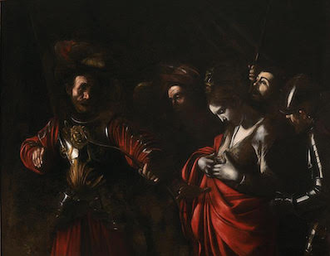The Last Caravaggio at the National Gallery

Michelangelo Merisi da Caravaggio The Martyrdom of Saint Ursula. Intesa Sanpaolo Collection Gallerie d'Italia - Napoli © Archivio Patrimonio Artistico Intesa Sanpaolo / foto Luciano Pedicini, Napoli
An atmospheric scenario of Film Noir confronts the viewer with cinematic gloom, in this riveting study of light and dark of Caravaggio's art. 'The Martyrdom of St Ursula' , painted in 1610, on loan from Naples, is exhibited in room 46 alongside 'Salome Receives the Head of St John the Baptist,' another powerful late work in the National Gallery's permanent Collection, and 17th century literary accounts of the infamous artists' life and death.
Born Michelangelo Merisi in 1592 but known as Caravaggio, after his hometown in Lombardy, he moved to Rome aged 21. Five years later Cardinal del Monte took him into his household and promoted the talented, innovative artist. However, his volatile temperament resulted in him killing a young man in a duel in 1595 and he fled to Naples and then to Malta. He sought to join the Knights of Malta thinking it would enable him to gain a papal pardon for his crime. In return for a painting of the beheading of John the Baptist he was granted membership. However, he got into a fight with a Knight and was expelled. He travelled to Sicily and returned to Naples where he was badly disfigured in another brawl.
He painted 'The Martyrdom of St Ursula' two months before he died. It was sent to Marcantonio Doria in Genoa on 27May 1610, who commissioned the painting. At the time his stepdaughter was struggling with her vocation as a nun .
Friends in Rome successfully obtained a Papal pardon and Caravaggio loaded his belongings aboard a ship, but he was mistakenly arrested and separated from his possessions and paintings which sailed without him. He managed to get released but was distraught to see the ship disappear. Making his way along the coast he caught malaria and died alone in Porto Ercole in 1610.
Ursula is listed in the Roman Martyrology as a fourth century saint. She is thought to be either a British princess from Llangwvyfon, near Aberystwyth or from Brittany. Various UK churches are dedicated to her. The site of the demolished church of St Mary Axe Church and street of the same name are situated near the Gherkin in London. The church was also dedicated to St Ursula and a manuscript of 1510 claimed there was 'a holy relic' of an axe used by the Huns to massacre her followers there. The chapel at Whitelands College in Roehampton, the oldest Anglican educational establishment, is dedicated to St Ursula.
St Angela Merici founded the Company of St Ursula, the first secular institute for women. A branch later developed into the Ursulines, an educational religious Order. St Ursula is one of 140 saints located on the North Colonnade around St Peter's Basilica, Rome.
Her pilgrimage with thousands of maiden companions was a popular narrative theme in art drawing on accounts from the Golden Legend. However, only Caravaggio homed in on the moment of her martyrdom by the barbarian King in Cologne. Lost for centuries it was only rediscovered in 1980, having been attributed to other artists, and in poor condition. Two letters dated May 1610 referring to the painting's commission and completion were discovered in 2004 in Naples Archives indisputably confirming the painting was by Caravaggio. The second letter is displayed here alongside the painting for the first time, revealing that it was placed in the sunshine to dry quicker.
A few male characters react vividly out of the darkness to the emotionally charged scene. One stretches out a hand between the key protagonists trying - too late - to prevent the martyrdom. This had had been overpainted, only becoming visible in recent restoration. Behind him a helmet is glimpsed as a soldier open mouthed clasps a lance in his hand. The King of the Huns' left hand holds the bow, his right drawn back having released the fatal arrow. His malevolent, contorted face seems anguished at what he has done in anger. Ursula's hands frame the arrow that has pierced her heart as she pensively embraces her instrument of martyrdom, calmly contemplating her transverberation - brutal not mystical - her approaching death bringing fulfilment of her spiritual marriage of union with Christ. A concerned, armoured soldier at her side stretches out a hand protectively.
Behind Ursula is the last self portrait of Caravaggio, who includes himself in the tragic scene. His face peers over her shoulder bearing a sickly pallor as he appears to look beyond the horrific action, perhaps fearful of his own approaching end.
Ursula's blood red cloak envelops her, mirroring her martyrdom, accentuating her marble like flesh and countenance. The Huns' similarly red cloak covers his arms tightly as he holds the instrument of that martyrdom. The painting 'amazed' Caravaggio's contemporaries and stuns us today.
Admission Free 18 April-21July.
See: www.nationalgallery.org.uk for for more information.


















